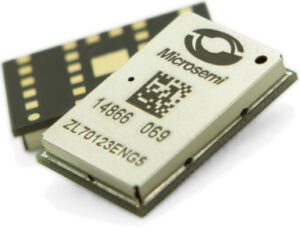 Radio frequency technology is increasingly being used in a wide variety of medical implantable applications, including cardiac care, physiological monitoring (e.g., insulin monitoring), pain management and obesity treatments. According to a recent report from P&S Research, the market for active implantable devices, which includes pacemakers, defibrillators and neurostimulators, is expected to grow at an eight percent compound annual growth rate (CAGR) over the next five years, reaching nearly $29 billion by 2023. Microsemi’s new ZL70123 base station module is ideally suited for the unique needs of this growing market.
Radio frequency technology is increasingly being used in a wide variety of medical implantable applications, including cardiac care, physiological monitoring (e.g., insulin monitoring), pain management and obesity treatments. According to a recent report from P&S Research, the market for active implantable devices, which includes pacemakers, defibrillators and neurostimulators, is expected to grow at an eight percent compound annual growth rate (CAGR) over the next five years, reaching nearly $29 billion by 2023. Microsemi’s new ZL70123 base station module is ideally suited for the unique needs of this growing market.
Microsemi’s ZL70123 base station module, when combined with the company’s existing ZL70323 implant module, provides a complete solution for achieving the highest performance in next-generation medical networks (Med-Net). Both modules are based on the latest generation of Microsemi’s ultralow power (ULP), MICS-band, radio transceiver chip, which has been deployed in more than three million implantable devices over the last 10 years.
The Med-Net radio operates in the 402 MHz to 405 MHz MICS band. Multiple ULP wake-up options are supported, including a 2.45-GHz, industrial, scientific and medical (ISM) band, wake-up option.
The existing Microsemi ZL70323 implant module implements all RF-related functions needed to deploy an implant node in a MICS-band RF telemetry system. It consumes less than six milliamps (mA) when transmitting or receiving data and consumes just 10 nanoamperes (nA) when in its sleep state. The integrated antenna tuning circuit allows the module to be used with a wide range of implant antennas (as nominal antenna impedance is 100+j150 ohms). The module includes the following major blocks:
· ZL70103-based MICS-band RF transceiver with integrated matching network, SAW filters for suppression of unwanted blockers and antenna tuning;
· 2.45-GHz wake-up receiver matching network;
· Integrated 24 MHz reference frequency crystal; and
· Decoupling capacitors.
The new Microsemi ZL70123 base station module includes all RF-related functions required to deploy external device functions in a MICS-band RF telemetry system. It is designed to meet regulatory requirements including Federal Communications Commission (FCC), European Telecommunications Standards Institute (ETSI) and International Electrotechnical Commission (IEC) standards. Additional features include:
· Integrated matching network with a nominal 50 ohm RF port;
· Bandpass filter for suppression of unwanted blockers;
· 2.45 GHz wake-up transmitter with a nominal 50 ohm RF port; and
· Fully shielded, 18 mm × 12 mm × 3 mm package.
Microsemi’s new ZL70123 RF base station module is in production and available now. The company also offers an application development kit (ADK) to qualified customers (part number ZLE70103BADA). To learn more, contact sales.supportr@microsemi.com or visit https://www.microsemi.com/existing-parts/parts/137899.
Leave a Reply